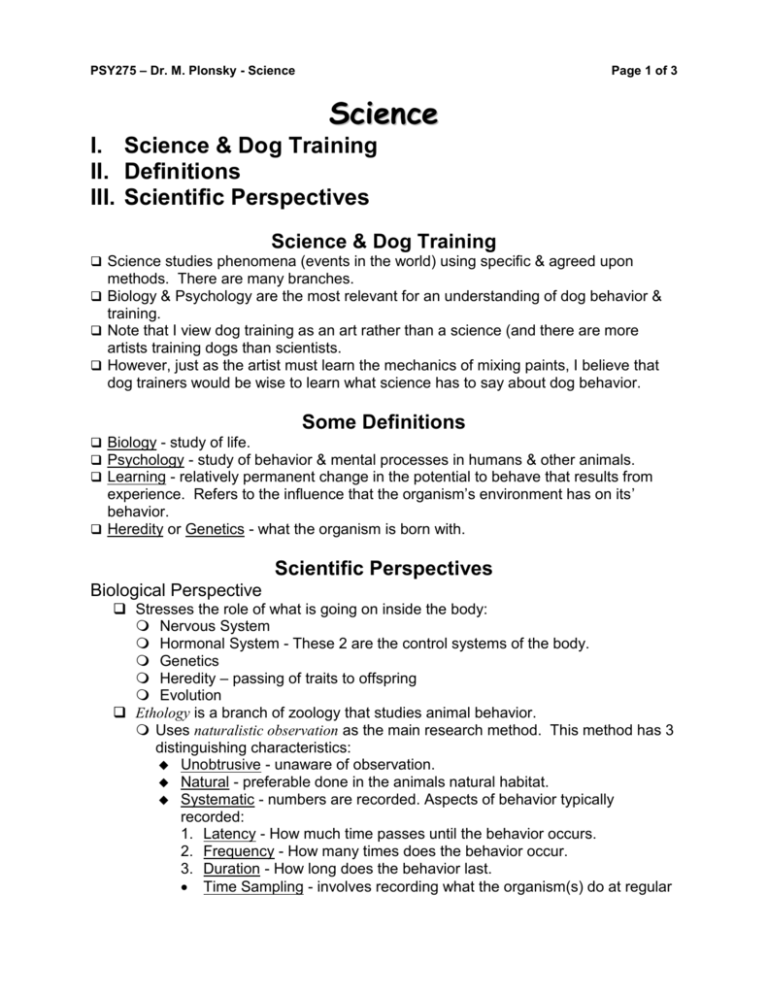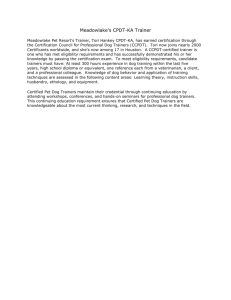Science - UWSP Home Page
advertisement

PSY275 – Dr. M. Plonsky - Science Page 1 of 3 Science I. Science & Dog Training II. Definitions III. Scientific Perspectives Science & Dog Training Science studies phenomena (events in the world) using specific & agreed upon methods. There are many branches. Biology & Psychology are the most relevant for an understanding of dog behavior & training. Note that I view dog training as an art rather than a science (and there are more artists training dogs than scientists. However, just as the artist must learn the mechanics of mixing paints, I believe that dog trainers would be wise to learn what science has to say about dog behavior. Some Definitions Biology - study of life. Psychology - study of behavior & mental processes in humans & other animals. Learning - relatively permanent change in the potential to behave that results from experience. Refers to the influence that the organism’s environment has on its’ behavior. Heredity or Genetics - what the organism is born with. Scientific Perspectives Biological Perspective Stresses the role of what is going on inside the body: Nervous System Hormonal System - These 2 are the control systems of the body. Genetics Heredity – passing of traits to offspring Evolution Ethology is a branch of zoology that studies animal behavior. Uses naturalistic observation as the main research method. This method has 3 distinguishing characteristics: Unobtrusive - unaware of observation. Natural - preferable done in the animals natural habitat. Systematic - numbers are recorded. Aspects of behavior typically recorded: 1. Latency - How much time passes until the behavior occurs. 2. Frequency - How many times does the behavior occur. 3. Duration - How long does the behavior last. Time Sampling - involves recording what the organism(s) do at regular PSY275 – Dr. M. Plonsky - Science Page 2 of 3 intervals of time. Emphasizes the role of instincts. Focuses on the uniqueness of behavior in a given species rather than general principles that apply to all species. Psychological Perspective Unlike the “hands off” approach of ethology, this view stresses control & manipulation. Emphasizes the role of the environment. Looks for general principles that apply to all species. Dominant research method used here is experimentation. Involves manipulating something we choose. As a result, it is the most powerful research method because it allows us to determine cause & effect. Purpose is to see if one variable causes changes in another. Variable - Characteristic of a person or thing that can occur in different amounts or kinds. Independent Variables (IVs) - We select and manipulate these. Dependent Variables (DVs) - We measure these. Extraneous Variables (EVs) - Variables other than the IV which can influence the DV. We worry about these. Some Exs. of IV’s - Use of food, special collars, training philosophy, diet, drugs. While we are discussing research methods, let us also mention surveys. Include: Questionnaires - without human contact. Interviews - voice or face-to-face contact. Important issues: Question Structure - Should not be leading. Who is Surveyed? - Should use a random sample (each member of the population has an equal chance of being in the sample). Behavioral Perspective In its extreme, this view believes the environment to be the sole determinant of behavior. Refers to the newborn as a tabula rasa (or blank slate). Stresses the observation & measurement of behavior. Is interested in general laws of learning. This view probably has the most “bang for its buck” in terms of its relevance to dog training. Is sometimes called the “Stimulus-Response (S-R) view” or “black box view”. Stimulus - an event in the environment. Can be simple or complex. Give Ex. Response - behavior. Cognitive Perspective Views animal as a processor of information. Folks interested in this view use PSY275 – Dr. M. Plonsky - Science Page 3 of 3 terms like thinking, prediction, control, expectancy, & insight. Thus, unlike strict behaviorism, this view considers what is going on inside the black box to be what is most important. This view also blends nicely with the behavioral view & the combination (called the cognitive-behavior view) has become quite popular in psychology. I should note that my personal emphasis on the application of the cognitivebehavioral view to dog training is unique among dog trainers. Social Perspective Concerned with the behavior of more than one organism at a time. Several relevant issues here include: Social Organization Dominance hierarchy can be linear or more complex. Social Facilitation Unique Relationship of Dog & Human Nonverbal communication Concerned with body language or being able to “read the dog”. It is important to be aware that dogs also read our emotional state & intentions. Thus, the handler’s postures, expressions, & movements are important to be aware of & control. Pfungst’s (1911) study of Wilhelm von Osten & his Russian trotting horse, clever Hans.









